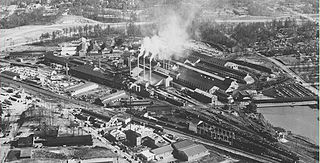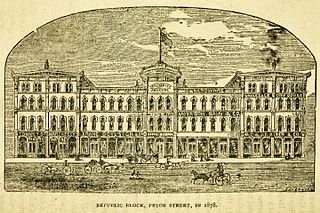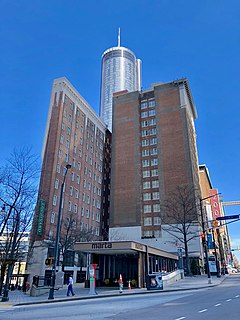
The Battle of Atlanta was a battle of the Atlanta Campaign fought during the American Civil War on July 22, 1864, just southeast of Atlanta, Georgia. Continuing their summer campaign to seize the important rail and supply hub of Atlanta, Union forces commanded by William Tecumseh Sherman overwhelmed and defeated Confederate forces defending the city under John Bell Hood. Union Maj. Gen. James B. McPherson was killed during the battle. Despite the implication of finality in its name, the battle occurred midway through the campaign, and the city did not fall until September 2, 1864, after a Union siege and various attempts to seize railroads and supply lines leading to Atlanta. After taking the city, Sherman's troops headed south-southeastward toward Milledgeville, the state capital, and on to Savannah with the March to the Sea.

The history of Atlanta dates back to 1836, when Georgia decided to build a railroad to the U.S. Midwest and a location was chosen to be the line's terminus. The stake marking the founding of "Terminus" was driven into the ground in 1837. In 1839, homes and a store were built there and the settlement grew. Between 1845 and 1854, rail lines arrived from four different directions, and the rapidly growing town quickly became the rail hub for the entire Southern United States. During the American Civil War, Atlanta, as a distribution hub, became the target of a major Union campaign, and in 1864, Union William Sherman's troops set on fire and destroyed the city's assets and buildings, save churches and hospitals. After the war, the population grew rapidly, as did manufacturing, while the city retained its role as a rail hub. Coca-Cola was launched here in 1886 and grew into an Atlanta-based world empire. Electric streetcars arrived in 1889, and the city added new "streetcar suburbs".

The Atlanta campaign was a series of battles fought in the Western Theater of the American Civil War throughout northwest Georgia and the area around Atlanta during the summer of 1864. Union Maj. Gen. William Tecumseh Sherman invaded Georgia from the vicinity of Chattanooga, Tennessee, beginning in May 1864, opposed by the Confederate general Joseph E. Johnston.

The Battle of Kennesaw Mountain was fought on June 27, 1864, during the Atlanta Campaign of the American Civil War. It was the most significant frontal assault launched by Union Maj. Gen. William T. Sherman against the Confederate Army of Tennessee under Gen. Joseph E. Johnston, ending in a tactical defeat for the Union forces. Strategically, however, the battle failed to deliver the result that the Confederacy desperately needed—namely a halt to Sherman's advance on Atlanta.
The Battle of Utoy Creek was fought August 4–7, 1864, during the Atlanta Campaign of the American Civil War. Maj. Gen. William T. Sherman's Union armies had partially encircled the city of Atlanta, Georgia, which was being held by Confederate forces under the command of General John Bell Hood. Sherman had at this point adopted a strategy of attacking the railroad lines into Atlanta, hoping to cut off his enemies' supplies. This was the third direct attack on Confederate positions during the campaign and the effect of success would have ended the siege and won Atlanta on 6 August 1864.

The Battle of Jonesborough was fought August 31–September 1, 1864, during the Atlanta Campaign in the American Civil War. Two Union armies led by Maj. Gen. William T. Sherman maneuvered to draw the Army of Tennessee away from their defenses at Atlanta, Georgia, so it could be destroyed.

Sherman's neckties were a railway-destruction tactic used in the American Civil War. Named after Maj. Gen. William Tecumseh Sherman of the Union Army, Sherman's neckties were railway rails destroyed by heating them until they were malleable and twisting them into loops resembling neckties, often around trees. Since the Confederacy had limited supplies of iron, and few foundries to roll the rails, this destruction was very difficult to repair. They were also called Sherman's Bowties, Jeff Davis's Neckties, and Sherman's hairpins.

The Franklin–Nashville campaign, also known as Hood's Tennessee campaign, was a series of battles in the Western Theater, conducted from September 18 to December 27, 1864, in Alabama, Tennessee, and northwestern Georgia during the American Civil War.

The city of Atlanta, Georgia, in Fulton County, was an important rail and commercial center during the American Civil War. Although relatively small in population, the city became a critical point of contention during the Atlanta Campaign in 1864 when a powerful Union Army approached from Union-held Tennessee. The fall of Atlanta was a critical point in the Civil War, giving the North more confidence, and leading to the re-election of President Abraham Lincoln and the eventual surrender of the Confederacy. The capture of the "Gate City of the South" was especially important for Lincoln as he was in a contentious election campaign against the Democratic opponent George B. McClellan.

55 Marietta Street, formerly the Fulton National Bank Building and the Bank South Building is a 21-story, 89.9 m (295 ft) office building in Atlanta, Georgia. It was the tallest building in the city when completed in 1958 until surpassed by One Park Tower in 1961. 55 Marietta Street is the site of the U.S. Post Office and Customs House, which served from 1910 to 1930 as City Hall

The Atlantic Steel Company was a steel company in Atlanta, Georgia with a large steel mill on the site of today's Atlantic Station multi-use complex.
The Fulton County Street Railroad Company of Atlanta, Georgia was organized in 1883 by:
Washington Hall was a historic hotel in antebellum Atlanta, Georgia. Built in 1846, the building was one of the earliest hotels built in the city. The hotel, along with many other structures in the city, was destroyed in 1864 during the Battle of Atlanta.
The Norcross Building occupied the southwest corner of Peachtree Street and Marietta Street at Five Points in downtown Atlanta. Today the Andrew Young School of Policy Studies is located on the site. The building was owned by Jonathan Norcross, "father of Atlanta."

The U.S Post Office and Customs House in Atlanta was a landmark building located on Marietta Street, occupying the block bounded by Marietta, Fairlie, Walton and Forsyth streets in the Fairlie-Poplar district of Downtown Atlanta. The building opened in 1878. In 1910 the City acquired the building and it was used as the Atlanta City Hall until 1930, after which it was razed. The lot was rebuilt in 1958 as the Fulton National Bank building, now the 55 Marietta Street building.

The Republic Block was at the time of its completion one of the most remarkable commercial constructions in Atlanta. It faced Pryor Street between Decatur St. and Railroad Ave., now site of Georgia State University buildings. It faced the Kimball House which stood across Pryor St. to the northwest. The block was built on the initiative of William Goodnow, a manager for the Republic Insurance Company of Chicago, with partners ex-governor Joseph E. Brown, Judge O. A. Lochrane, and othersIts first tenants were hardware mostly wholesale and other dealers, as well as an architect, attorney, a bank, the Atlanta Chamber of Commerce, as well as the Republic Insurance Company.

The Huff House was for decades the oldest house in the city of Atlanta. It was located at the northeast corner of Huff Road and Ellsworth Industrial Avenue. at 1133 Huff Road NW in Blandtown, part of what is today West Midtown, overlooking the site of the Battle of Peachtree Creek. It was the family home of Sara Huff, the author of the memoir My 80 Years in Atlanta. Jeremiah Huff built the house of pine and brick in 1854 or 1855 over the remnants of an 1830s log cabin. It was razed in 1954 to make way for the Rushton Toy Factory building. This was covered on the front page of the Atlanta paper at the time. Perennial Properties bought the factory site in 2006, demolished the factory in 2008, and the Apex West Midtown residential development is now located at the site.
Tenth Street is a street in Midtown Atlanta, Georgia.

This article is about hotels in Atlanta, including a brief history of hotels in the city and a list of some notable hotels.
















